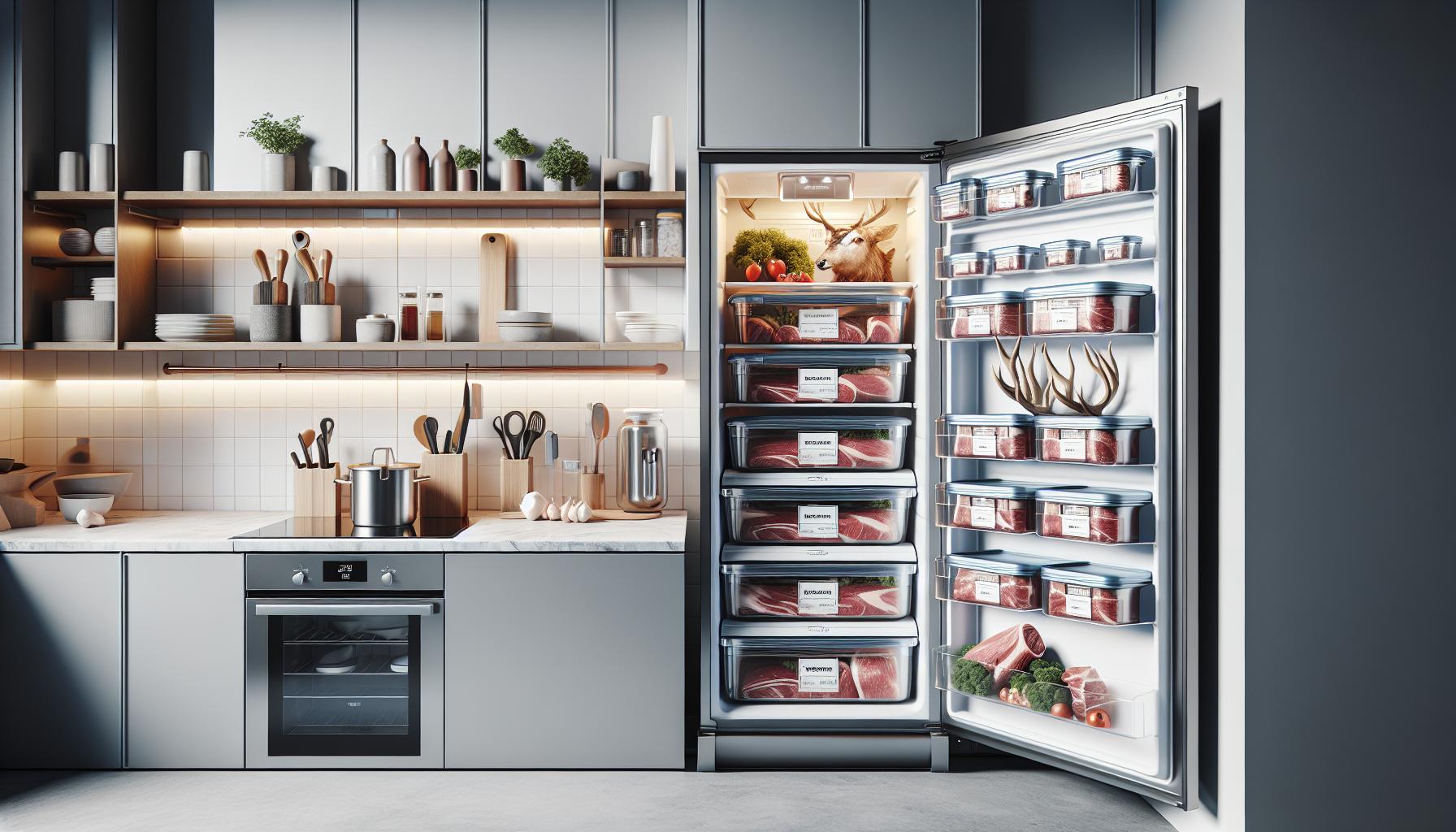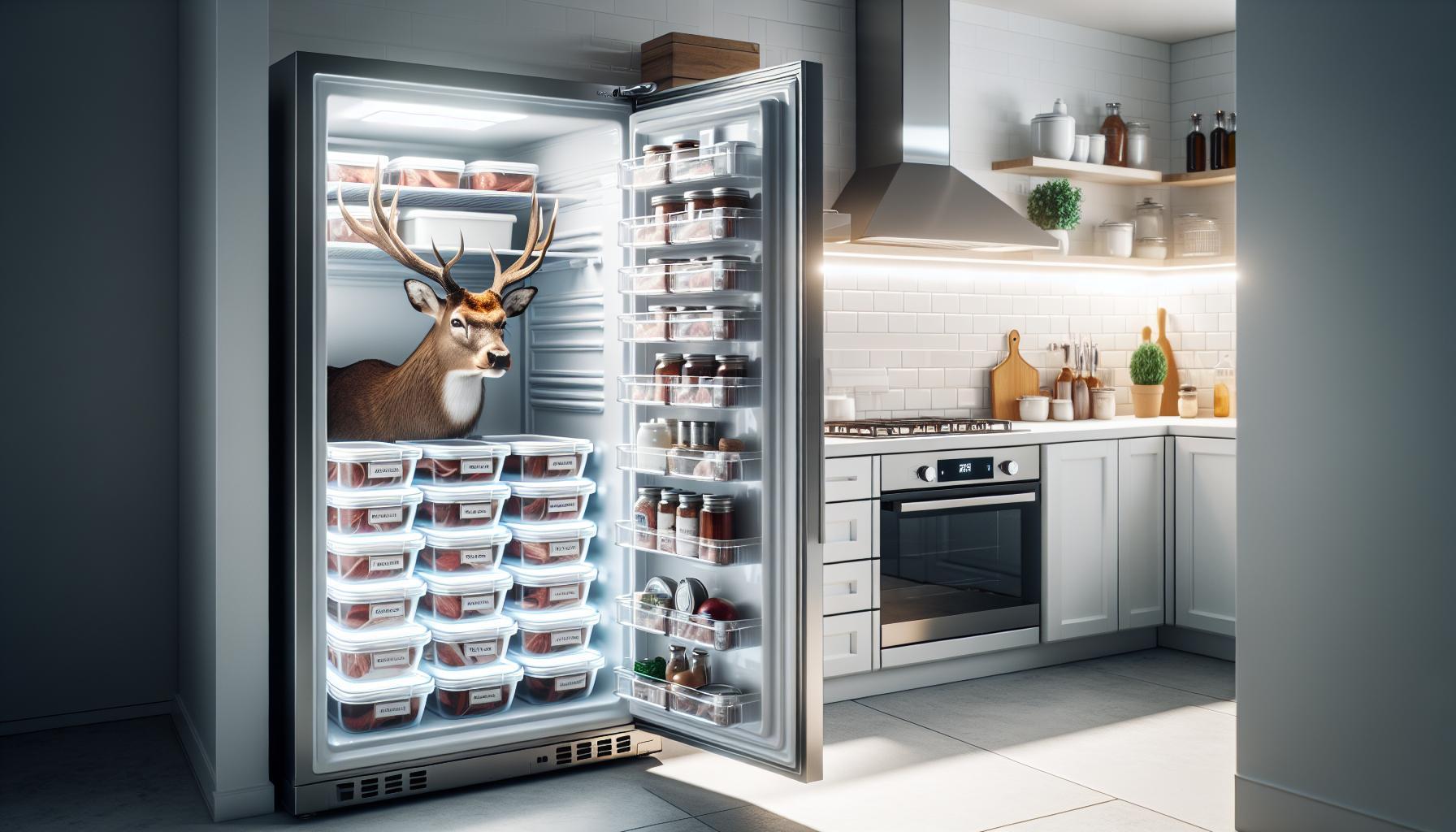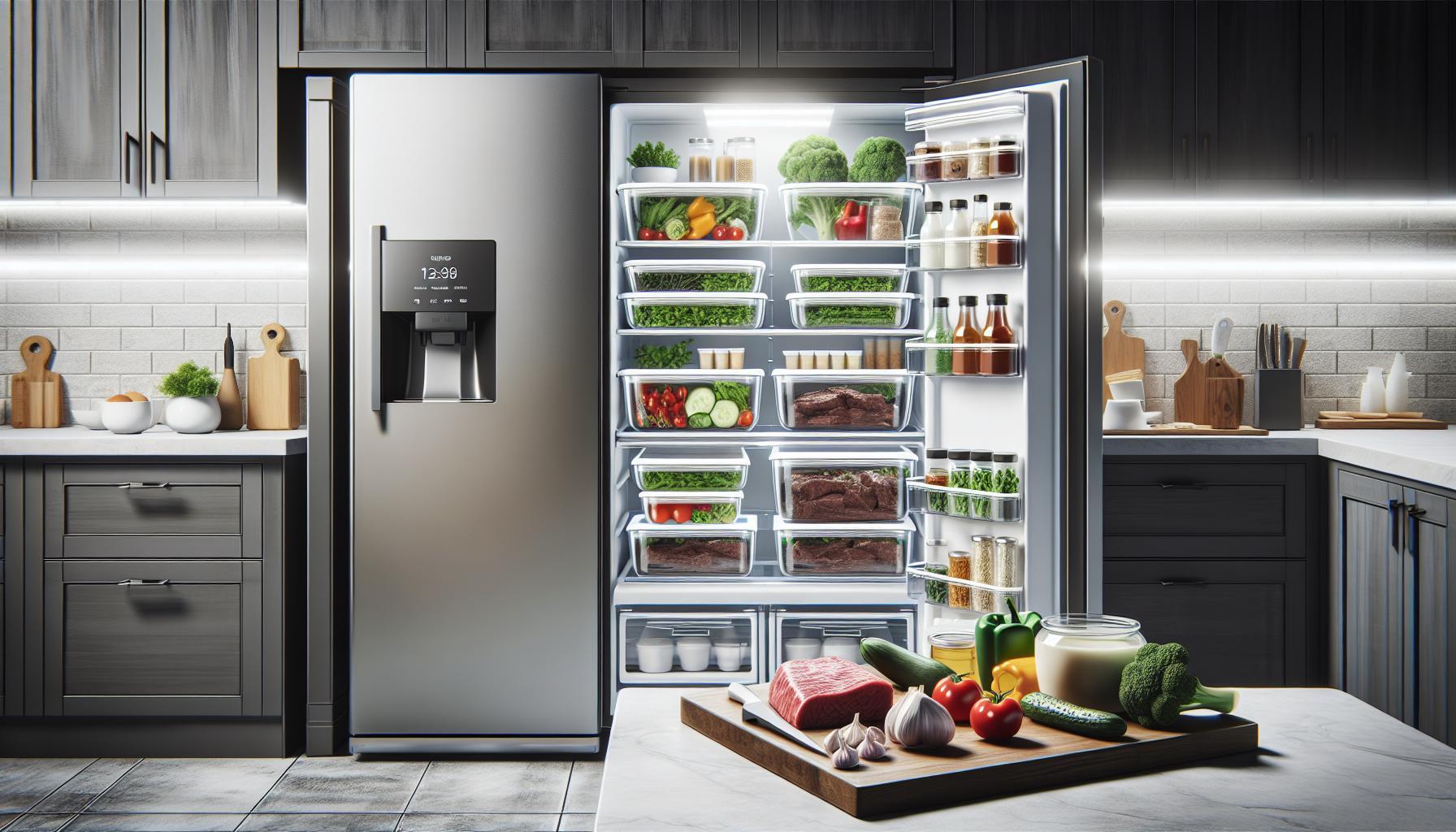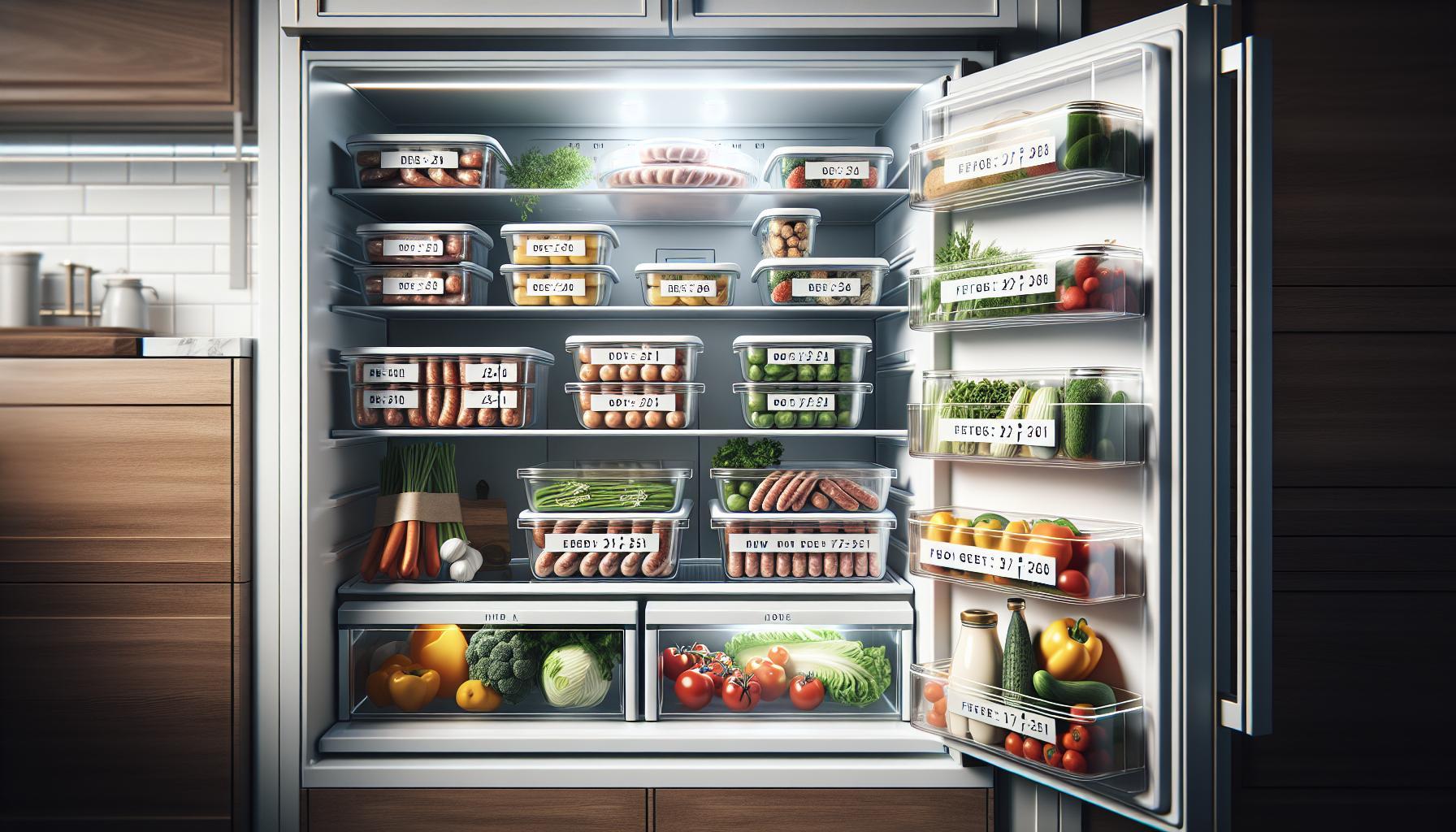Did you know that properly frozen venison can last up to a year without losing its quality? Understanding how long venison lasts in the freezer is crucial, especially for hunters and meat enthusiasts who want to make the most of their harvest. Improper storage can lead to spoilage and waste, affecting both your budget and culinary plans.
In this ultimate guide, we will explore safe storage practices, offering you clear timeframes and practical tips to ensure that your venison remains fresh and delicious. Whether you’re interested in preserving the distinct flavor of your game meat or simply ensuring food safety, this guide will address your questions and help you make informed decisions. Dive in to discover the essential methods for freezing and storing venison that will keep it in optimal condition for months to come.
How Long Can You Safely Freeze Venison?

Fresh venison is a prized meat, rich in flavor and leaner than traditional meats, but knowing how long it can safely be frozen is crucial for both quality and safety. When appropriately stored in a consistent freezer that maintains a temperature of 0°F (-18°C) or lower, venison can retain its best quality for quite some time. Typically, whole cuts of venison can be safely frozen for up to 12 months, while ground venison holds up to 3 to 4 months without significant loss of flavor or texture.
To ensure venison remains safe for consumption during its time in the freezer, proper handling and packaging are essential. Use freezer-safe wraps or vacuum seal bags to prevent freezer burn, which can affect the meat’s flavor and quality. If unsure about the time elapsed, always check for any signs of spoilage, such as off smells or discoloration, before cooking. Following these guidelines can help maintain the quality of your venison, allowing you to enjoy delicious meals long after the hunting season has ended.
In summary, storing venison correctly in the freezer can enhance your culinary experience and ensure food safety. By adhering to the recommended storage times, utilizing suitable packaging, and monitoring the condition of your meat, you can savor this delightful game meat without worry.
Understanding Freezer Storage Times for Venison

When it comes to preserving the rich flavors of venison, understanding how long you can safely freeze it is essential. This game meat is not only delicious but also tends to spoil more quickly than conventional meats if not handled properly. To maintain its quality and safety, venison should be stored diligently in a well-functioning freezer, ideally set at or below 0°F (-18°C).
Here are the recommended storage times for different cuts of venison:
| Type of Venison | Recommended Freezer Storage Time |
|---|---|
| Whole cuts (steaks, roasts) | Up to 12 months |
| Ground venison | 3 to 4 months |
| Cooked venison dishes | 2 to 3 months |
To ensure optimal freshness, it’s crucial to use proper packaging methods. Avoid freezer burn by wrapping venison in heavy-duty aluminum foil, freezer paper, or vacuum-seal bags, which can significantly extend its storage life. Keep in mind that while venison may remain safe to eat beyond these timeframes, its quality can diminish-leading to potential off-flavors and unwanted textures.
Additionally, it’s important to check the condition of your stored venison periodically. If you notice any signs of freezer burn, such as discolored patches or an off smell, it is best to discard the meat to avoid compromising your dishes. Taking these simple steps can allow you to enjoy the unique richness of venison in your meals, even long after the hunting season has wrapped up.
Best Practices for Preparing Venison for Freezing

Preparing venison for freezing requires careful consideration to maintain its quality and flavor. Start by ensuring that the meat is as fresh as possible-ideally, it should be frozen soon after it is processed. When handling raw venison, it is essential to keep everything clean to prevent cross-contamination. Wash your hands, utensils, and surfaces thoroughly before and after preparation.
Trim any visible fat, sinew, or silver skin from the venison to improve its texture and reduce potential gamey flavors. Cut the meat into manageable portions if you’ll be using it for various recipes later. For instance, slicing the venison into steak cuts, cubes for stew, or grinding for sausage allows for better organization and makes it easier to thaw only what you need.
Utilize effective freezing techniques to prolong the shelf life of your venison. Wrap each portion tightly in plastic wrap, then in aluminum foil or freezer paper to minimize air exposure. Vacuum sealing is another excellent option, as it removes air and prevents freezer burn, safeguarding the meat’s natural juices and flavors. Label each package with the date and contents to help keep track of storage times and maintain an orderly freezer.
Remember, the way you freeze venison can impact its quality. Rapid freezing is ideal, as it helps preserve the texture and flavor. If using a traditional freezer, ensure it’s operating at 0°F (-18°C) or lower. Avoid overcrowding, which can hinder air circulation and proper freezing. Following these best practices will ensure that your venison stays safe, flavorful, and ready for delicious meals down the road.
Essential Tips for Properly Packaging Venison
When it comes to preserving the quality of venison in your freezer, proper packaging is crucial. Inadequate packaging can lead to freezer burn, which adversely affects the texture and flavor of the meat. By following a few essential steps, you can ensure that your venison maintains its quality and remains safe to eat across long storage periods.
Start by using plastic wrap to tightly encase individual cuts or portions of venison. Make sure to remove as much air as possible during this process, as air exposure can contribute to freezer burn. After wrapping in plastic, it’s beneficial to further wrap the meat in aluminum foil or freezer paper for an additional layer of protection against air and moisture. For the best results, consider vacuum sealing your venison. Vacuum sealing systems eliminate almost all air around the meat, thus extending its shelf life while preserving its natural flavors.
Labeling each package is another vital step in the packaging process. Clearly mark the contents and the date of freezing. This practice not only helps you track how long the venison has been stored but also aids in meal planning. For instance, vacuum-sealed venison can generally last for 6 to 12 months without significant quality loss, while properly wrapped cuts may last around 4 to 6 months.
Lastly, ensure that your freezer is set to 0°F (-18°C) or lower to maintain optimal preservation conditions. Avoid overcrowding the freezer, as effective air circulation is necessary for consistent freezing. By adhering to these essential packaging tips, you can enjoy high-quality venison for many months, ensuring your dishes remain delicious and satisfying.
Signs of Spoiled Venison: Storage Life and Quality
To ensure the enjoyable consumption of venison, it’s crucial to recognize the signs of spoilage. Spoiled venison can pose health risks and should be discarded immediately. Unlike some meats that can mask spoilage with strong spices or sauces, the characteristics of venison make it more distinguishable when it has gone bad.
When evaluating the quality of your venison, first consider its smell. Fresh venison has a mild, earthy aroma, while spoiled venison can emit a sour or rancid odor. If you detect a strong or off-putting smell, it’s advisable to err on the side of caution and dispose of the meat. Another notable sign of spoilage is the appearance of the surface. Fresh venison should be deep red in color with a slight sheen. If the meat appears dull, gray, or has developed a slimy texture, these are reassurance indicators that the venison is no longer safe to eat.
In addition to sensory cues, pay attention to any freezer burn, which appears as white or grayish patches on the meat’s surface. While freezer-burned meat may still be safe to eat, the quality in terms of flavor and texture can be significantly compromised. Freshly frozen venison will typically last within optimal quality for 6 to 12 months. If the meat has been in the freezer for longer than that, even if it appears fine, it’s best to inspect it closely for any signs of spoilage.
If at any point you are uncertain about the meat’s safety, remember that when in doubt, throwing it out is the safest option. Proper handling and storage can greatly extend the lifespan and quality of venison, but always prioritize safety above all else to enjoy the best flavors and nutritional benefits.
How to Thaw Venison Safely and Effectively
Thawing venison safely is crucial to maintaining its quality and preventing any foodborne illnesses. When it comes to meat, including venison, never leave it out at room temperature to thaw. This practice encourages the growth of harmful bacteria that can thrive in the “danger zone” temperatures between 40°F and 140°F (4°C and 60°C). Instead, there are safe and effective methods to ensure your venison is thawed while maintaining its taste and texture.
One of the best methodologies is to plan ahead and let your venison thaw gradually in the refrigerator. This process can take several hours to overnight, depending on the size of the cut. The refrigeration method keeps the meat at a safe temperature, preventing bacterial growth while allowing it to thaw evenly. As a rule of thumb, small cuts may take around 6-8 hours, while larger cuts could need up to 24 hours or more.
If you’re short on time, another effective method is to use cold water. Seal the venison in a leak-proof plastic bag to prevent contamination, and submerge it in cold water, changing the water every 30 minutes to maintain a safe temperature. This method typically thaws venison in about an hour, depending on the size of the piece. It’s essential to cook the meat immediately after thawing using this method to ensure safety and quality.
Lastly, the microwave is also an option for quick thawing, but it can partially cook the meat, which can affect texture and flavor. If you choose this method, be sure to cook the venison immediately after thawing to mitigate any risk. Always keep food safety in mind, and when in doubt, err on the side of caution to ensure a delicious and safe meal.
Freezing Techniques: Whole Cuts vs. Ground Venison
When it comes to freezing venison, understanding the difference between whole cuts and ground venison is key to ensuring quality and safety. Whole cuts, like steaks and roasts, generally retain their texture and flavor better during freezing compared to ground venison. This is mainly due to the larger pieces of muscle fibers and less surface area exposed to air and freezer burn. If packaged properly, whole cuts can maintain their best quality in the freezer for 6 to 12 months, while ground venison is best used within 3 to 4 months.
When preparing whole cuts for freezing, it’s crucial to trim any excess fat, as fat can go rancid and affect the meat’s flavor over time. Wrap the cuts tightly in heavy-duty plastic wrap or freezer paper, then place them in a labeled freezer bag, ensuring to push out as much air as possible. Label with the date and type of cut for easy identification. For optimal results, consider using a vacuum sealer to further protect the meat from freezer burn and maintain moisture.
Ground venison, on the other hand, has a different freezability profile due to its increased surface area. To freeze ground venison effectively, divide it into portion sizes that your family would typically use in one meal. Pack it in airtight freezer bags, squeezing out the excess air before sealing. Ground venison can also be vacuum sealed for improved preservation. Due to moisture loss, ground meat may experience changes in texture, but it remains safe to consume if stored correctly.
To sum up, both whole cuts and ground venison can be successfully frozen, but whole cuts generally last longer and better retain quality over time. By properly preparing and packaging your venison before freezing, you can enjoy its rich, gamey flavor long after the harvest season has ended.
Impact of Freezing on Venison Flavor and Texture
The flavor and texture of venison can be significantly impacted by freezing, but with proper techniques, you can preserve the meat’s quality and delicious characteristics. When venison is frozen, ice crystals form in the meat’s cellular structure. If the freezing process is slow, larger ice crystals can develop, causing cell walls to rupture, which may lead to a mushier texture upon thawing. This is especially true for ground venison, which has a higher surface area that is more susceptible to moisture loss and may result in a grainy texture. Conversely, whole cuts tend to fare better and retain their original texture and flavor profile when frozen correctly.
To minimize texture loss, it’s important to freeze venison as quickly as possible. Ideally, you’ll want to use a deep freezer that maintains a consistent and low temperature, as this allows for rapid freezing. Individual cuts should be well-wrapped in airtight packaging, whether in vacuum-sealed bags or heavy-duty freezer paper, to limit exposure to air and prevent freezer burn. Vacuum sealing is particularly effective, as it removes air from the packaging and can maintain moisture levels, thus preserving flavor and texture better than traditional plastic wrap or standard freezer bags.
Flavor retention is another key factor when freezing venison. If the meat isn’t properly packaged, exposure to oxygen can lead to oxidation, which adversely affects both taste and color, often resulting in a more metallic flavor. This can be mitigated by ensuring all packaging is airtight and by minimizing the time venison spends in the freezer. For optimal results, use within 6 to 12 months for whole cuts and within 3 to 4 months for ground venison, keeping in mind that while the meat may remain technically safe to eat past these timeframes, the flavor and texture may diminish.
Ultimately, while freezing does alter the structural integrity of venison, diligent handling practices and proper freezing techniques can ensure the meat retains its rich, gamey flavor and desirable texture, allowing you to enjoy it long after the harvest season.
Can You Refreeze Venison? What You Need to Know
Once thawed, the question of refreezing venison can be a concern for many home cooks. The good news is that you can refreeze venison as long as certain conditions are met. If the meat has been thawed in the refrigerator and has not exceeded the safe thawing period of about 1 to 2 days, it is safe to refreeze it. However, this practice can affect the quality of the meat. Each freeze-thaw cycle can contribute to moisture loss and result in a less desirable texture.
When considering refreezing, it’s crucial to assess the meat’s condition before doing so. If the venison was thawed using methods such as cold water or the microwave, it should be cooked immediately before either consuming or freezing again. Repeated cycles of thawing and refreezing may not only compromise flavor and texture but can also increase the risk of spoilage.
Here are some tips for refreezing venison effectively:
- Thaw Safely: Always thaw venison in the refrigerator for best results.
- Avoid Temperature Abuse: Do not leave thawed venison at room temperature for extended periods.
- Wrap Well: When refreezing, ensure the venison is tightly wrapped in airtight packaging to minimize exposure to air.
- Label Your Packages: Include the date and original freezing date to track how long it has been stored.
Keep in mind that while refreezing is safe under the right conditions, it’s advisable to minimize how often you do so. To maintain the highest quality, always try to use venison within the recommended periods: for best flavor and texture, consider consuming it within 6 to 12 months for whole cuts and within 3 to 4 months for ground venison. By following these guidelines, you can enjoy your venison at its best without compromising safety or quality.
Storing Venison in Different Freezer Types
When it comes to preserving venison, the type of freezer you use can significantly influence the meat’s quality and shelf life. Understanding how different freezer types operate and their storage capacities can help you choose the best option for your venison. Conventional kitchen freezers, chest freezers, and commercial-grade freezers each have unique advantages that impact freezing effectiveness and overall meat preservation.
Conventional kitchen freezers, typically found in refrigerator units, maintain a temperature of 0°F (-18°C) or below, making them suitable for short to medium-term storage. While they can effectively freeze and preserve venison for several months, the limited capacity may require careful organization to ensure all packages are packed tightly and efficiently. It’s essential to keep freezing times in mind: whole cuts of venison can last 6 to 12 months, while ground meat is best consumed within 3 to 4 months.
Chest Freezers
Chest freezers are a popular choice for those who frequently process game meat or store larger quantities. They typically hold more than conventional freezers, allowing for organized storage of multiple packages of venison. Their design tends to retain cold air better, which means the temperature remains stable even when the lid is opened. This feature makes chest freezers an ideal option for long-term storage, as they can preserve the quality and flavor of venison for up to a year or more if kept at or below 0°F (-18°C).
Commercial-Grade Freezers
For serious hunters or meat processors, investing in a commercial-grade freezer may be logical. These freezers offer larger storage capacities and are built to withstand more frequent use. They often provide advanced temperature control features, which can enhance efficiency and ensure that your venison is stored safely. With proper management, meat in commercial freezers can maintain optimal quality for extended periods, even beyond the average recommended time frames, as long as temperatures are consistently maintained.
- Use Airtight Packaging: Regardless of the freezer type, ensure that venison is vacuum-sealed or wrapped well to prevent freezer burn.
- Organize Accordingly: Label packages with dates and types of cuts to maintain a first-in, first-out system.
- Regularly Monitor Temperatures: Keep an eye on your freezer’s temperature settings, especially after power outages or defrosting cycles.
In summary, selecting the right freezer type for storing venison is crucial for ensuring quality and safety. Whether you opt for a traditional kitchen freezer, a chest freezer, or a commercial-grade unit, understanding how they function and implementing best practices can help you make the most of your venison storage.
Additional Storage Tips for Game Meat Safety
To ensure the safety and quality of venison during storage, it’s essential to adopt best practices that minimize the risk of spoilage and contamination. Game meat, due to its unique composition and handling requirements, demands attention to detail to preserve its freshness and flavor.
First, always freeze venison promptly after processing or purchase. Leaving it at room temperature too long increases the risk of bacterial growth, which can compromise safety. Use a thermometer to verify that your freezer maintains a stable temperature of 0°F (-18°C) or below. This is crucial for keeping venison safe over longer storage periods.
When packaging venison for freezing, consider methods that reduce air exposure. Vacuum-sealing is the most effective, as it not only prevents freezer burn but also keeps meat moisture intact. If vacuum-sealing isn’t an option, tightly wrap the meat in heavy-duty aluminum foil or freezer paper and place it in resealable plastic bags, expelling as much air as possible before sealing.
It’s equally important to label your packages with the date and type of cut. This practice helps keep track of storage times and assists in utilizing older meat first, adhering to the first-in, first-out principle. Implementing this method can further extend the usability of your stored venison.
Finally, remain vigilant for signs of spoilage, including off odors, discoloration, or a slimy texture. Properly stored venison should have no unusual smells or textures. If you encounter any of these signs, it’s best to err on the side of caution and discard the meat. By following these guidelines, you can confidently store your venison, ensuring safety and maintaining its high quality for your culinary enjoyment.
Q&A
Q: How long can sliced venison stay in the freezer?
A: Sliced venison can safely be frozen for up to 6 months when properly packaged. Ensure you use airtight vacuum-sealed bags or heavy-duty plastic wrap to maintain quality and prevent freezer burn. For optimal taste and texture, consume within this timeframe.
Q: What is the best way to package venison for freezing?
A: The best way to package venison for freezing is to vacuum seal it or wrap it tightly in plastic wrap, then aluminum foil or freezer paper. This technique minimizes air exposure, preventing freezer burn and maintaining the meat’s quality over time.
Q: Can you store cooked venison in the freezer, and how long does it last?
A: Yes, cooked venison can be stored in the freezer, lasting up to 3 months. Ensure it’s cooled completely before packaging in airtight containers or freezer bags to preserve flavor and quality upon reheating.
Q: Is it safe to eat venison that has been in the freezer for over a year?
A: While venison can remain safe indefinitely in the freezer, quality diminishes over time. After a year, it may suffer from freezer burn, losing taste and texture. It’s best to consume it within 6-12 months for optimal flavor.
Q: What are signs that frozen venison has gone bad?
A: Signs that frozen venison has gone bad include off odors, changes in color (like browning), and the presence of ice crystals or freezer burn. If the meat appears dry or tough, it’s best to discard it to avoid foodborne illness.
Q: Can you freeze ground venison and how long can it last?
A: Ground venison can be frozen and lasts for about 3-4 months. Wrap it tightly in freezer-safe packaging to reduce air exposure, which helps maintain its quality and prevent freezer burn over this period.
Q: Should you thaw venison in the refrigerator or at room temperature?
A: Venison should be thawed in the refrigerator to ensure a safe thawing process. This method keeps the meat at a safe temperature, minimizing the risk of bacterial growth. Avoid thawing at room temperature to prevent unsafe conditions.
Q: Is marinating venison before freezing a good idea?
A: Yes, marinating venison before freezing can enhance flavor and tenderness. Just ensure it’s tightly sealed in a marinade that won’t compromise quality, and consume it within 3 months for the best taste.
Feel free to explore these tips for safe venison storage to ensure the best quality and flavor for your meals!
The Conclusion
By understanding how long venison lasts in the freezer and following proper storage techniques, you can enjoy this delicious meat without worrying about its safety. Remember, vacuum sealing and organizing your freezer can enhance longevity and maintain quality. If you have any lingering questions about meat storage or want to explore more tips on preserving game meats, check out our articles on safe thawing methods and optimal freezing practices.
Don’t miss out-subscribe to our newsletter for more expert advice, and feel free to share your experiences with venison storage in the comments below! Explore our site further to discover delicious venison recipes and preparation guides that will elevate your cooking game while ensuring safe and tasty meals every time. Your journey to mastering venison preservation starts now!





